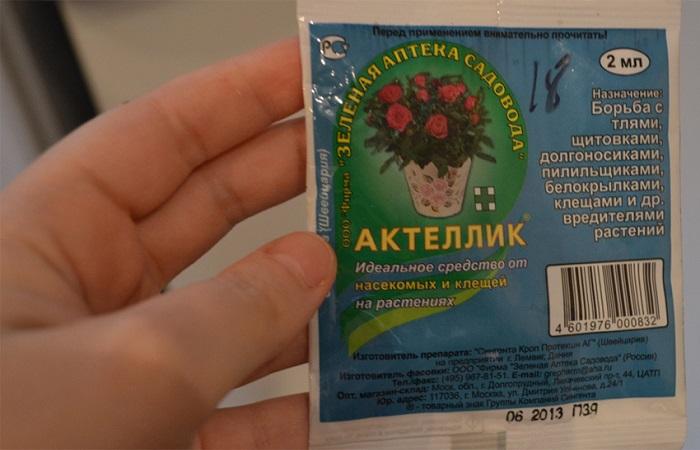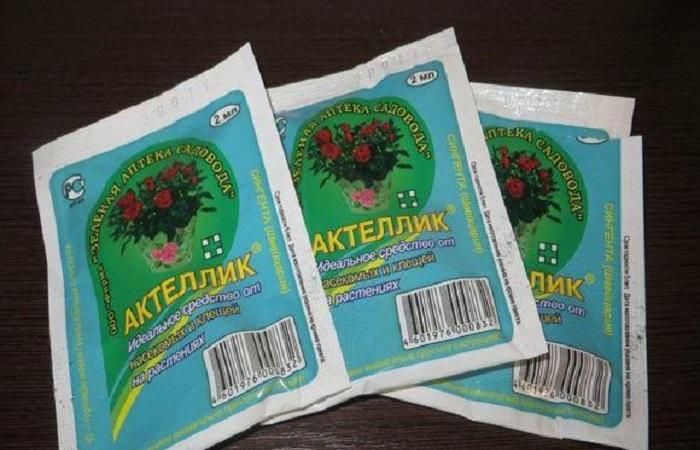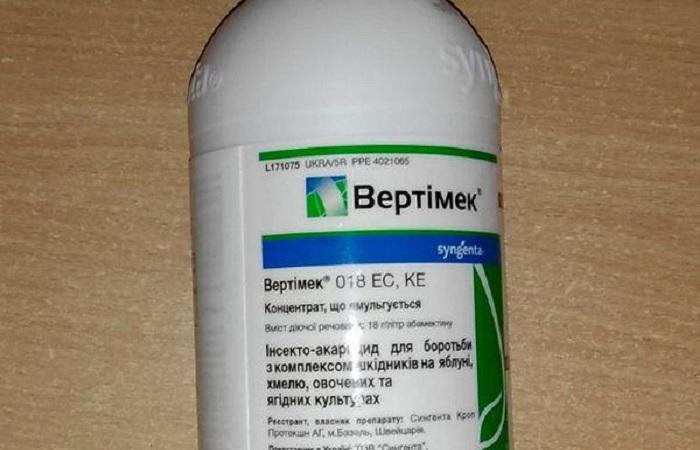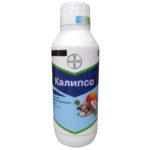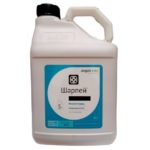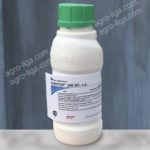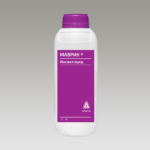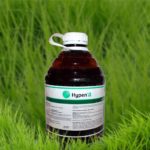Stock pests can damage grain in warehouses and thereby cause significant harm. There are drugs to combat them. Let's look at the composition, purpose and action of Actellik, how to use it according to the instructions, and precautions. How to store the insecticide, what products it is compatible with, what it is allowed to replace it with. Advantages and disadvantages of the drug.
What is it, composition and principle of action
“Actellik” is an insectoacaricide from the FOS group and belongs to the enteric contact drugs.It is used for processing unfilled warehouses, equipment of food and grain processing enterprises, their territories, as well as all types of grain itself: seeds, food and feed. Treated against a complex of barn pests.
The active ingredient of the insecticide is pirimiphos-methyl in an amount of 500 g per 1 liter. Produced by Syngenta in the form of an emulsion concentrate, in 5 liter canisters and 2 ml ampoules (for use in private household plots).
Pirimiphos-methyl disrupts the biometabolism of acetylcholine and the enzyme acetylcholinesterase. As a result, the functions of the central nervous system of insects are disrupted, which leads to the death of pests. The drug "Actellik" is able to penetrate plant tissues; when processing grain, it perfectly penetrates into each grain, as it has a fumigant effect. This effect is enhanced at a temperature of 15 ° C and high humidity. In hot weather, at temperatures above 25-30 ° C, the effect of the drug is reduced.
When to use
"Aktellik" is used in warehouses before storing grain in them to clean them of pests that may be in the room. The insecticide acts on insects when the solution or vapor comes into contact with the skin (as a fumigant). Intestinal effects have also been noted when insects eat processed grains. It is treated by fumigation; the volatile insecticide penetrates well into the grain mass.
Instructions for use
For the treatment of warehouses, the application rate for Actellik is 0.4 ml per square meter. m, consumption – up to 50 ml/m2. Work in warehouses and loading them with grain is allowed 3 days after processing. The application rate for treating areas is 0.8 ml per square meter. m, consumption – 200 ml per sq. m. For grain processing, the dosage is 16 ml per ton, consumption is 500 ml per ton.Admission of people - no earlier than 24 hours after fumigation.
The drug is also used on private farms for spraying ornamental crops, vegetables, flowers, and berry bushes against scale insects, aphids, whiteflies, mites, thrips, sawflies, moths, and weevils. Application rate for different crops and consumption:
- ornamental plants – 2 ml per 1 liter (5 sq. m.);
- for indoor plants – 2 ml per 1.5 l (15 sq. m.);
- tomatoes and cucumbers in a greenhouse - 2 ml per 0.5 l (2 sq. m);
- tomatoes and cucumbers in beds - 2 ml per 1.7 l (7 sq. m.);
- berries and strawberries - 2 ml per 1.5 l (10 sq. m.);
- honeysuckle – 2 ml per 1.5 l (per plant).
The frequency of treatments with Actellik is 2, for ornamental plants – 4.
"Aktellik" protects greenhouse crops for 1-2 weeks, 2-3 weeks for those growing in beds and 6-12 months for processed grain. The first application of an insecticide is recommended when pests appear; to spray plants, prepare enough solution so that the leaves are completely wetted. The drug "Actellik" is effective, so it can be used in a minimum dosage for spraying young plants or if the pests have not yet had time to reproduce. You can increase the dosage and consumption if there are a large number of pests and on plants with large foliage.
To uniformly cover the leaves with the Actellika solution, you need to use a fine-drop sprayer to ensure high-quality application of the working fluid. Spraying should be carried out on warm and humid days; such conditions enhance the effect of the drug. If the air is dry or cool, efficiency may be reduced.
Security measures
Actellik is toxic to bees, fish, and birds (hazard class 1). For humans, hazard class 2.Do not carry out treatment in the presence of animals and children, in areas located near gardens, fields, and fish farms. Work only in protective clothing made of thick fabric and with long sleeves to protect against contact of the solution with the skin of your hands, in household gloves, a respirator or thick mask and plastic goggles with side protection.
To keep contact with Actellik to a minimum, you should not eat, drink, smoke while working, and try not to touch your face with your hands. After finishing the treatment, you should wash your face and hands with soap, neutralize your clothes in a soda solution and wash them in clean water.
Spraying of garden plants should be carried out in moderate weather; on days when there is no wind, it should not be sprayed before rain, since the solution is not resistant to washing off. The waiting period for Actellik is 20 days, so the last treatment should be carried out 3 weeks before harvesting the fruits. Fruits picked before this date should not be consumed.
First aid
If the Actellik insecticide solution gets on your skin, you should quickly wash it off with water. If the solution gets into your eyes, rinse with running water. If it enters the gastrointestinal tract, drink activated carbon tablets (1 piece per 10 kg of weight) and drink 1 liter of water. Induce vomiting after 15 minutes. If symptoms of poisoning persist, consult a doctor immediately. Treatment is symptomatic.
Storage conditions and shelf life
Actellik insecticide is stored for 3 years from the date of production. What storage conditions must be observed: temperature from -15 C to +30 C, dry and ventilated room. Storage is permitted only in the original packaging, unopened or undamaged. Canisters must be closed with lids.Keep separately from food, livestock feed, medicines and household products, in a room where access to children and animals is prohibited.
Do not store Actellik diluted with water; its shelf life expires one day after preparation. Do not use the concentrate after the expiration date.
Advantages and disadvantages
Advantages of "Aktellika":
- used to destroy pests in warehouses and their territories;
- quickly suppresses harmful insects;
- prevents the reappearance of pests;
- is effective even when remaining on inert surfaces, which is why it has a long period of action;
- controls pests that are difficult to access;
- destroys insects resistant to pyrethroids.
Disadvantages of the Actellik insecticide:
- Strong smell;
- toxicity;
- dangerous for bees;
- does not mix in mixtures with acid and alkaline reaction preparations.
Due to toxicity to bees, the insecticide is not recommended for use during the flowering period of trees.
Compatibility
With frequent use of Actellik in insects that produce several generations per season, addiction may develop, so the insecticide must be alternated with insecticides that contain substances from other chemicals. groups.
The product can be mixed with neutral pesticides and biological products. When treated 2 times with a break of a week with a mixture of “Aktellika” and “Aktar” or “Vermitek”, the effectiveness of both pesticides increases.
Analogues of the product
For use in agriculture, products containing pyrifos-methyl are produced: “Kamikaze”, “Prokrop”, “Zernospas”, “Pirigren”. They are also used for treating warehouses, surrounding areas and stored grain.
When used correctly, the drug does not accumulate in grain, so it can even be used to treat feed or food supplies. The product does not change the taste and smell of grain, does not make it toxic when consumed. Effective against pests that have developed resistance to pyrethroids.

